Embarking on DIY plumbing projects requires the right equipment to ensure success. Having the proper plumbing supplies on hand can make a significant difference in the outcome of your project.
Whether you’re fixing a leak or installing new pipes, using quality plumbing equipment is crucial. It not only makes the job easier but also ensures a professional finish.
Key Takeaways
- Having the right plumbing tools is essential for DIY projects.
- Quality plumbing supplies ensure a professional finish.
- Proper equipment makes plumbing tasks easier and safer.
- Investing in good plumbing equipment is cost-effective in the long run.
- Being prepared with the right tools enhances your DIY experience.
Why Every DIY Enthusiast Needs Quality Plumbing Supplies
For DIY enthusiasts, having quality plumbing supplies is crucial for tackling household projects efficiently. Whether it’s fixing a leaky faucet or installing new pipes, the right tools can make all the difference.
Cost Savings of DIY Plumbing
One of the primary benefits of DIY plumbing is the potential for cost savings. By taking on plumbing projects yourself, you can avoid the labor costs associated with hiring a professional plumber. Additionally, purchasing the right plumbing supplies can help you avoid costly repairs down the line.
Common Household Plumbing Issues
Household plumbing issues are common and can range from leaky faucets to clogged drains. Having the right plumbing tools on hand can help you address these issues quickly and effectively. Some common issues include low water pressure, running toilets, and frozen pipes.
Benefits of Having the Right Tools on Hand
Having the right plumbing supplies and tools can make a significant difference in the success of your DIY projects. It not only saves time but also ensures that the job is done correctly. With the right tools, you can tackle a variety of plumbing tasks, from simple fixes to more complex installations.
Essential Hand Tools for DIY Plumbing Projects
For anyone embarking on DIY plumbing projects, the correct hand tools are a must-have. These tools not only make the job easier but also ensure that tasks are completed efficiently and safely. In this section, we’ll explore the essential hand tools that every DIY plumber should have in their toolkit.
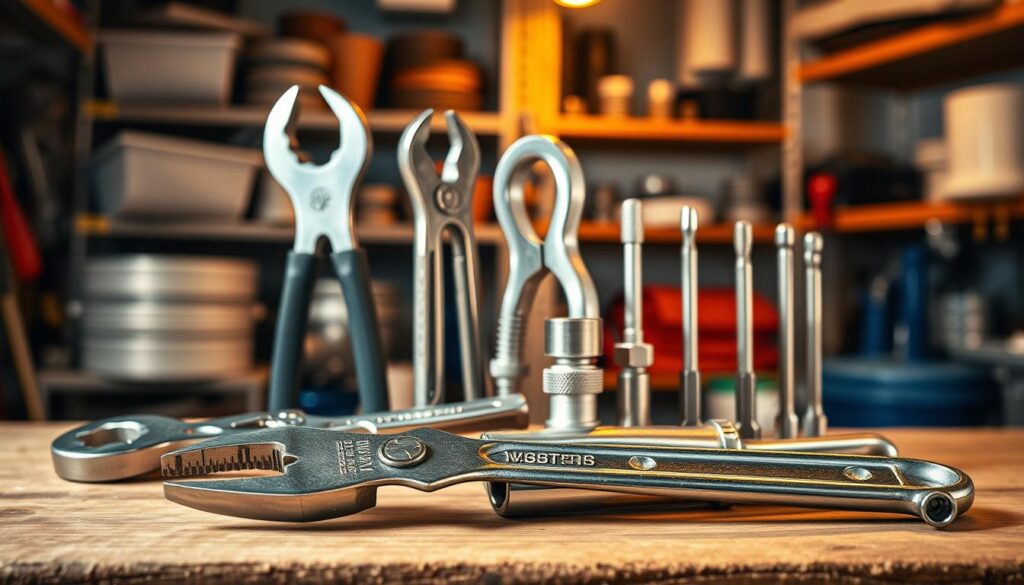
Pipe Wrenches and Adjustable Wrenches
Pipe wrenches are a fundamental tool in any DIY plumber’s arsenal. They are used to grip and twist pipes, making them indispensable for tasks like fixing leaks or replacing pipe sections. Adjustable wrenches complement pipe wrenches by providing flexibility for various pipe sizes. Together, they form a crucial pair for any plumbing task.
Pliers and Gripping Tools
Pliers are versatile tools that come in handy for gripping and bending various objects. Needle-nose pliers are particularly useful for reaching into tight spaces, while slip-joint pliers can adjust to grip different sizes of objects. These tools are essential for tasks that require precision and a firm grip.
Screwdrivers and Hex Keys
Screwdrivers and hex keys are vital for assembling and disassembling plumbing fixtures. A set of flathead and Phillips-head screwdrivers covers most tasks, while hex keys are necessary for fixtures that use hexagonal bolts. Having the right screwdrivers and hex keys on hand can save time and frustration.
Measuring and Marking Tools
Measuring and marking tools are crucial for ensuring accuracy in DIY plumbing projects. A tape measure allows for precise length measurements, while a level ensures that installations are perfectly horizontal or vertical. Marking tools like pencils and markers help in labeling pipes and fixtures, making the project more organized.
In conclusion, having the right hand tools is fundamental to the success of DIY plumbing projects. By equipping yourself with pipe wrenches, pliers, screwdrivers, and measuring tools, you’ll be well-prepared to tackle a variety of plumbing tasks with confidence.
Specialized Plumbing Tools for Home Projects
For DIY enthusiasts tackling complex plumbing projects, having the right specialized tools is crucial for achieving professional-grade results. These tools not only make the job easier but also ensure that the work is done safely and to a high standard.
Pipe Cutters and Tubing Cutters
Pipe cutters are essential for any plumbing project, allowing for clean, precise cuts in pipes. There are various types, including manual and ratcheting cutters, each suited to different materials and pipe sizes.
Pipe Benders and Flaring Tools
Pipe benders enable DIYers to shape pipes to fit specific angles and configurations without damaging the pipe. Flaring tools are used to create a flare on the end of a pipe, which is crucial for creating secure, leak-proof connections.
Soldering and Welding Equipment
Soldering and welding are critical skills for many plumbing projects. Soldering involves melting solder around a joint to secure it, while welding fuses two metal pieces together. Both require specific equipment, including torches, solder, and flux.
Thread Sealants and Joining Materials
Thread sealants, such as Teflon tape and pipe dope, are used to create watertight seals on threaded connections. Other joining materials, like soldering flux and welding rods, are essential for preparing and securing joints.
| Tool | Primary Use | Key Features |
|---|---|---|
| Pipe Cutters | Cutting pipes | Precision cutting, various sizes |
| Pipe Benders | Shaping pipes | Flexible, durable |
| Soldering Equipment | Joining pipes | High-temperature, precise |
| Thread Sealants | Sealing threaded connections | Watertight, durable |
Must-Have Plumbing Tools and Pipes for DIY Enthusiasts
Every DIY enthusiast should be equipped with essential plumbing tools to handle common plumbing issues. Having the right tools not only makes the job easier but also ensures safety and efficiency. In this section, we’ll explore the must-have plumbing tools and pipes that every DIY enthusiast should consider including in their toolkit.
Essential Tools for Every Homeowner
Certain tools are fundamental for any DIY plumbing project. These include pipe wrenches, adjustable wrenches, and pliers, which are used for gripping and twisting pipes and fittings. A level and tape measure are also essential for ensuring that pipes are properly aligned and measured. As “A good workman is known by his tools”, having these basics covered is crucial.
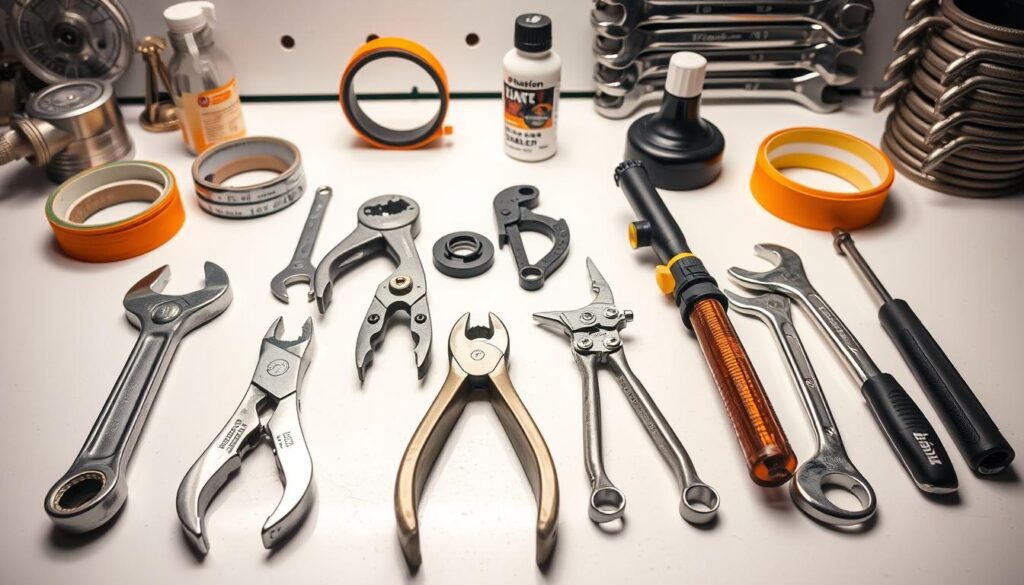
Specialized Tools Worth the Investment
While basic tools get you started, specialized tools can significantly enhance your ability to tackle more complex plumbing tasks. Pipe cutters and tubing cutters are indispensable for cutting pipes cleanly and accurately. Additionally, soldering and welding equipment are necessary for joining pipes securely. Investing in these specialized tools can save time and improve the quality of your work.
Tools for Emergency Plumbing Situations
Plumbing emergencies can happen at any time, and being prepared is key. Essential tools for emergency situations include a shut-off wrench to turn off the main water supply, Teflon tape for creating watertight seals, and a plunger for clearing clogs. As a wise plumber once said,
“Preparation is the key to handling plumbing emergencies effectively.”
Having these tools on hand can mitigate damage and stress during unexpected plumbing issues.
Drain Cleaning Tools for DIY Plumbers
Effective drain cleaning is essential for maintaining a healthy plumbing system, and the right tools make all the difference. DIY plumbers often encounter clogs and blockages that require immediate attention, and having the appropriate equipment can simplify this task.
Manual Drain Snakes and Augers
Manual drain snakes and augers are fundamental tools for clearing clogs in drains. These tools are designed to navigate through pipes and physically remove blockages. They are available in various lengths, making them suitable for different types of clogs and pipe configurations.
Key benefits: Effective for removing hair and soap buildup, easy to use, and cost-effective.
Plungers and Force Cups
Plungers are another essential tool for DIY plumbers. They work by creating suction to dislodge clogs. There are different types of plungers, including sink plungers and toilet plungers, each designed for specific applications.
Tips for use: Ensure a good seal around the drain, and use a firm, consistent plunging motion.
Chemical Drain Cleaners
Chemical drain cleaners can be effective for dissolving clogs, especially those caused by grease and soap buildup. However, they should be used with caution as they can damage pipes and pose health risks.
Safety precautions: Wear protective gloves and eyewear, and follow the manufacturer’s instructions.
Drain Cameras and Inspection Tools
Drain cameras are advanced tools that allow DIY plumbers to inspect the inside of pipes. They are invaluable for diagnosing the cause and location of clogs and other issues.
Benefits: Provides a clear visual diagnosis, helps in pinpointing the problem area, and aids in planning the repair.
By equipping yourself with these drain cleaning tools, you can tackle common plumbing issues effectively and maintain a healthy plumbing system.
Understanding Different Types of Plumbing Pipes
Different plumbing projects require different types of pipes, each with its unique characteristics and applications. The choice of pipe material can significantly affect the durability, efficiency, and overall cost of a plumbing system.
PVC and CPVC Pipes
PVC (Polyvinyl Chloride) and CPVC (Chlorinated Polyvinyl Chloride) pipes are popular for plumbing due to their resistance to corrosion and chemical damage. PVC pipes are commonly used for drainage and venting, while CPVC pipes are used for hot and cold water supply lines because they can withstand higher temperatures.
Advantages: Both PVC and CPVC pipes are cost-effective, easy to install, and resistant to corrosion.
Copper Pipes and Fittings
Copper pipes have been used for plumbing for centuries due to their durability and reliability. They are excellent for both hot and cold water supply lines and are often used in high-pressure systems.
Key Benefits: Copper pipes are resistant to corrosion, can withstand high pressures, and have antimicrobial properties.
PEX Tubing Systems
PEX (Cross-linked Polyethylene) tubing is a flexible and versatile piping solution that has gained popularity in modern plumbing. It’s suitable for both hot and cold water supply lines and is known for its ease of installation and resistance to freezing.
PEX Advantages: Flexible, resistant to scale and chlorine, and can withstand freezing temperatures.
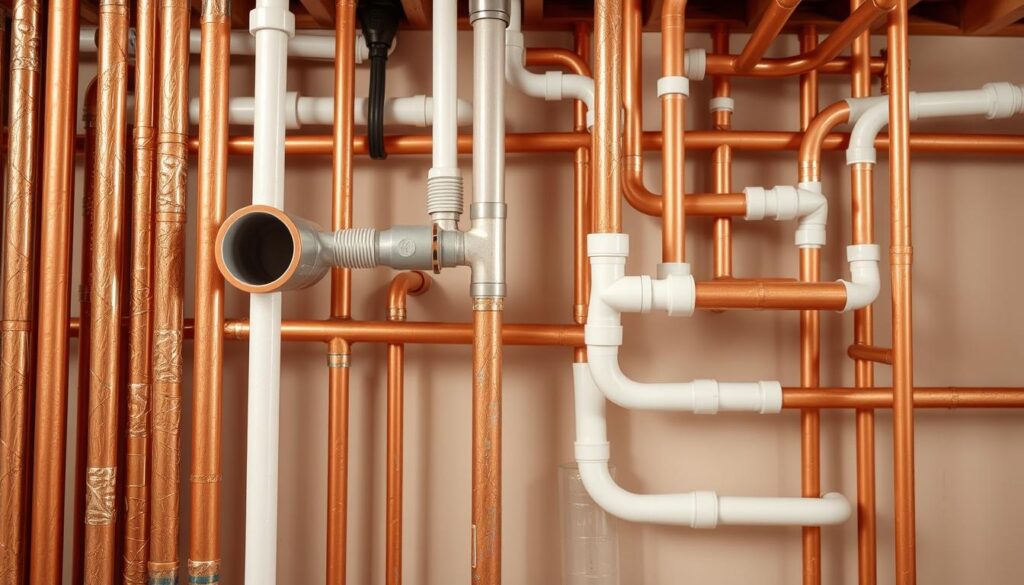
ABS and Cast Iron Pipes
ABS (Acrylonitrile Butadiene Styrene) pipes are used primarily for drainage and venting due to their chemical resistance and impact strength. Cast iron pipes, on the other hand, are known for their durability and are often used for drainage systems.
Galvanized and Stainless Steel Pipes
Galvanized pipes are steel pipes coated with a layer of zinc to prevent corrosion. They have been used historically for water supply lines but are less common today due to the risk of corrosion over time. Stainless steel pipes are highly resistant to corrosion and are used in applications where durability is critical.
| Pipe Material | Common Uses | Key Characteristics |
|---|---|---|
| PVC/CPVC | Drainage, venting, water supply | Corrosion-resistant, cost-effective |
| Copper | Water supply lines | Durable, antimicrobial |
| PEX | Water supply lines | Flexible, resistant to scale and chlorine |
| ABS | Drainage, venting | Chemical-resistant, impact-resistant |
| Cast Iron | Drainage systems | Durable, sound-absorbing |
| Galvanized Steel | Historically used for water supply | Corrosion-prone over time |
| Stainless Steel | High-pressure applications | Highly corrosion-resistant, durable |
Understanding the different types of plumbing pipes and their applications is crucial for any DIY plumbing project. By choosing the right material, homeowners can ensure their plumbing system is efficient, durable, and safe.
Pipe Fittings and Connectors for DIY Projects
Understanding pipe fittings and connectors is crucial for any DIY plumbing project. These components are essential for joining, redirecting, and controlling the flow of water through pipes. Choosing the right fittings and connectors ensures a leak-free and efficient plumbing system.
Elbows, Tees, and Crosses
Elbows, tees, and crosses are fundamental fittings used to change the direction of pipes or connect multiple pipes together. Elbows are used to change the direction of a pipe by 90 or 45 degrees. Tees allow for the connection of three pipes, while crosses connect four pipes at a single junction. These fittings are available in various materials, including PVC, copper, and PEX.
Couplings and Unions
Couplings are used to connect two pipes together, ensuring a secure and watertight seal. Unions, on the other hand, allow for the easy disconnection of pipes for maintenance or repairs. Both couplings and unions are essential for DIY plumbing projects, providing flexibility and convenience.
| Fitting Type | Material | Application |
|---|---|---|
| Elbows | PVC, Copper | Changing pipe direction |
| Tees | PVC, Copper, PEX | Connecting multiple pipes |
| Couplings | PVC, Copper | Connecting two pipes |
Adapters and Reducers
Adapters are used to connect pipes of different types or sizes, while reducers are used to connect pipes of different diameters. These fittings are crucial for adapting existing plumbing systems to new fixtures or appliances.
“The right pipe fittings can make a significant difference in the success of a DIY plumbing project.” – Plumbing Expert
Valves and Shut-offs
Valves control the flow of water through pipes, while shut-offs are used to completely stop the flow of water. These fittings are essential for regulating water pressure and preventing damage during repairs.
In conclusion, understanding and selecting the right pipe fittings and connectors is vital for the success of any DIY plumbing project. By choosing the correct fittings, DIY enthusiasts can ensure a safe, efficient, and leak-free plumbing system.
Selecting the Right Plumbing Tools and Pipes for Your Project
Selecting the right plumbing tools and pipes is a critical step in any DIY plumbing project. The success of your project depends on making informed decisions about the tools and materials you use.
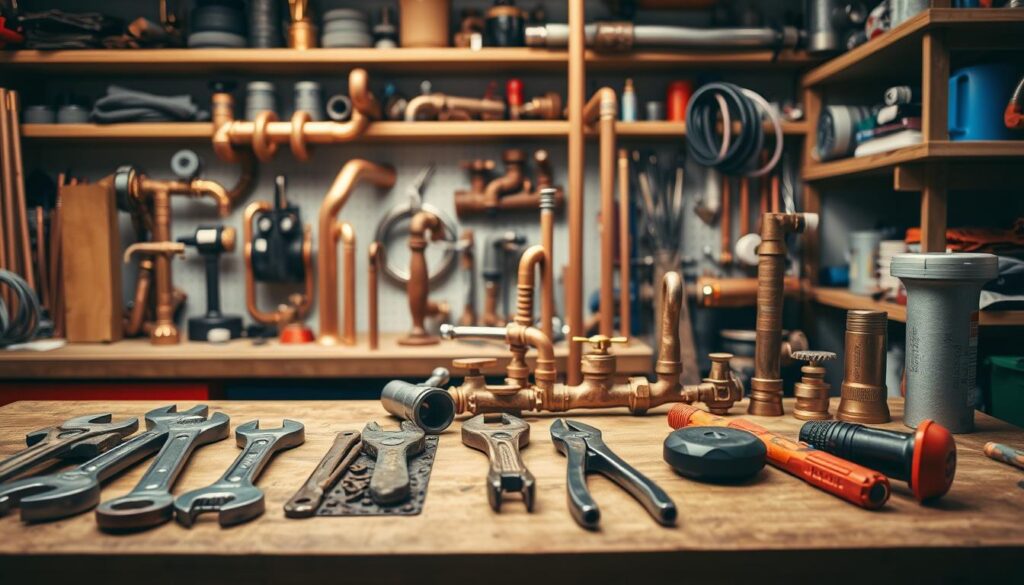
Matching Tools to Your Specific Project
It’s essential to match your tools to the specific requirements of your project. For instance, if you’re working with different types of pipes, you’ll need the appropriate pipe cutters and fittings. Using the right tools can prevent damage to your pipes and fixtures.
Choosing Pipes Based on Application
The type of pipe you choose depends on the application. For example, PVC pipes are commonly used for drainage, while copper pipes are often used for water supply lines due to their durability and resistance to corrosion.
| Pipe Type | Application | Benefits |
|---|---|---|
| PVC | Drainage | Resistant to corrosion, easy to install |
| Copper | Water supply lines | Durable, resistant to corrosion |
| PEX | Water supply lines | Flexible, resistant to freezing |
Budget Considerations for DIY Plumbing
When it comes to DIY plumbing, budget is a significant factor. While it’s tempting to opt for the cheapest tools and materials, it’s crucial to balance cost with quality. Investing in quality tools and pipes can save you money in the long run by reducing the need for repairs.
Quality vs. Cost Analysis
When analyzing the trade-off between quality and cost, consider the long-term benefits of investing in higher-quality tools and pipes. While they may be more expensive upfront, they can provide significant savings over time.
Building Your DIY Plumbing Tool Kit
Building a DIY plumbing tool kit is a gradual process that requires careful planning and consideration of your specific needs. As you start with basic repairs and move on to more complex projects, your tool kit should evolve accordingly. A well-structured tool kit not only makes your work easier but also ensures that you’re prepared for any plumbing task that comes your way.
Starter Kit Essentials
Every DIY plumbing tool kit should start with some essential tools. These include a pipe wrench, adjustable wrench, pliers, screwdrivers, and a plunger. These tools will help you tackle common plumbing issues such as leaky faucets and clogged drains. As John Doe, a renowned plumber, once said, “A good set of basic tools is the foundation of any successful plumbing project.”
Intermediate Tool Additions
As you gain more experience, you can expand your tool kit with intermediate tools. These may include pipe cutters, tubing benders, and soldering equipment. With these additional tools, you’ll be able to take on more complex tasks like pipe installations and repairs. It’s essential to invest in quality tools that will last and perform well.
Advanced Tools for Serious DIYers
For serious DIY enthusiasts, advanced tools can make a significant difference. These may include drain cameras, pipe snakes, and specialized welding equipment. Such tools enable you to diagnose and fix complex issues efficiently. As noted by
“The right tools can transform a daunting task into a manageable one.”
Investing in these advanced tools will elevate your DIY plumbing capabilities.
In conclusion, building a DIY plumbing tool kit is a step-by-step process that should be tailored to your needs and experience level. By starting with the basics and gradually adding more advanced tools, you’ll be well-equipped to handle any plumbing task.
Safety Equipment and Precautions for DIY Plumbing
The importance of safety in DIY plumbing cannot be overstated, as it prevents accidents and ensures a successful project outcome. When working on plumbing tasks, it’s crucial to be aware of the potential hazards and take necessary precautions to minimize risks.
Personal Protective Equipment
Personal protective equipment (PPE) is vital for safeguarding against injuries and exposure to harmful substances. Essential PPE for DIY plumbing includes:
- Safety Glasses: Protects eyes from debris, chemicals, and other hazardous materials.
- Gloves: Provides grip, protection from cuts, and insulation against extreme temperatures.
- Face Mask: Prevents inhalation of dust, fumes, and other airborne contaminants.
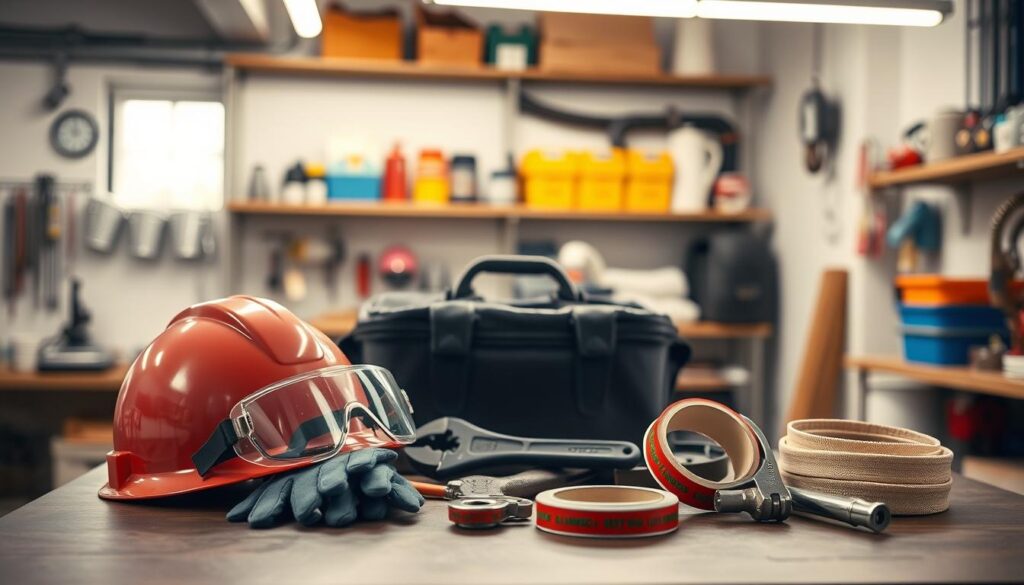
Workspace Safety Considerations
Maintaining a safe workspace is critical for preventing accidents. This includes:
- Clearing Clutter: Ensures easy movement and reduces tripping hazards.
- Proper Lighting: Illuminates the work area, reducing the risk of mistakes and accidents.
- Ventilation: Prevents the accumulation of harmful fumes and maintains a comfortable working environment.
| Safety Measure | Description | Benefit |
|---|---|---|
| Clear Workspace | Remove clutter and obstructions | Reduces tripping hazards and improves mobility |
| Adequate Lighting | Ensure sufficient lighting in the work area | Reduces the risk of accidents and improves visibility |
| Proper Ventilation | Maintain good airflow to prevent fume buildup | Prevents inhalation of harmful substances and maintains comfort |
Emergency Shut-off Knowledge
Understanding how to shut off the main water supply is crucial in case of emergencies. This knowledge can help prevent extensive water damage and facilitate a swift response to plumbing emergencies.
To ensure you’re prepared:
- Locate the Main Shut-off Valve: Familiarize yourself with the location of the main water shut-off valve.
- Understand How to Operate It: Know how to turn off the water supply quickly and effectively.
- Practice: Regularly check and practice shutting off the main water supply to ensure you’re prepared in case of an emergency.
Top Brands for Quality Plumbing Supplies
The world of plumbing supplies is vast, but certain top brands stand out for their quality and reliability. Whether you’re a seasoned DIY enthusiast or just starting out, choosing the right brand can make a significant difference in the outcome of your projects.
Professional-Grade Tool Manufacturers
For professional-grade tools, brands like Ridgid and DeWalt are highly regarded for their durability and performance. These manufacturers offer a wide range of tools, from pipe wrenches to drill sets, that are designed to withstand heavy use.
Another notable brand is Milwaukee, known for its high-quality power tools that are essential for demanding plumbing tasks. Their tools are designed to provide precision and reliability, making them a favorite among professionals and serious DIYers alike.
Reliable Pipe and Fitting Brands
When it comes to pipes and fittings, SharkBite is a popular choice due to its innovative push-fit fittings that simplify installation. Uponor is another trusted brand, offering a range of PEX tubing systems that are known for their flexibility and resistance to corrosion.
NIBCO is also a well-respected brand in the plumbing industry, providing a comprehensive range of fittings, valves, and other plumbing components that meet high standards of quality and durability.
| Brand | Product Range | Notable Features |
|---|---|---|
| Ridgid | Pipe wrenches, drill sets | Durable, high-performance tools |
| SharkBite | Push-fit fittings | Easy installation, reliable connections |
| Uponor | PEX tubing systems | Flexible, corrosion-resistant |
Budget-Friendly Options for DIYers
For those on a budget, brands like Generic and HDX offer affordable plumbing supplies without compromising on quality. These brands provide a range of tools and materials that are suitable for smaller DIY projects.
It’s also worth considering Klein Tools, which offers a variety of plumbing tools at competitive prices. Their products are known for being both durable and affordable, making them an excellent choice for DIY enthusiasts.
Where to Purchase Quality Supplies
Quality plumbing supplies can be found at various retailers, both online and in-store. Home Depot and Lowe’s are popular choices, offering a wide selection of products from top brands.
Online retailers like Amazon also provide a convenient platform to purchase plumbing supplies, often with customer reviews and competitive pricing.
Common DIY Plumbing Projects and Required Tools
Understanding the tools needed for common DIY plumbing projects is essential for success. Homeowners can tackle various plumbing tasks with confidence when equipped with the right tools and knowledge.
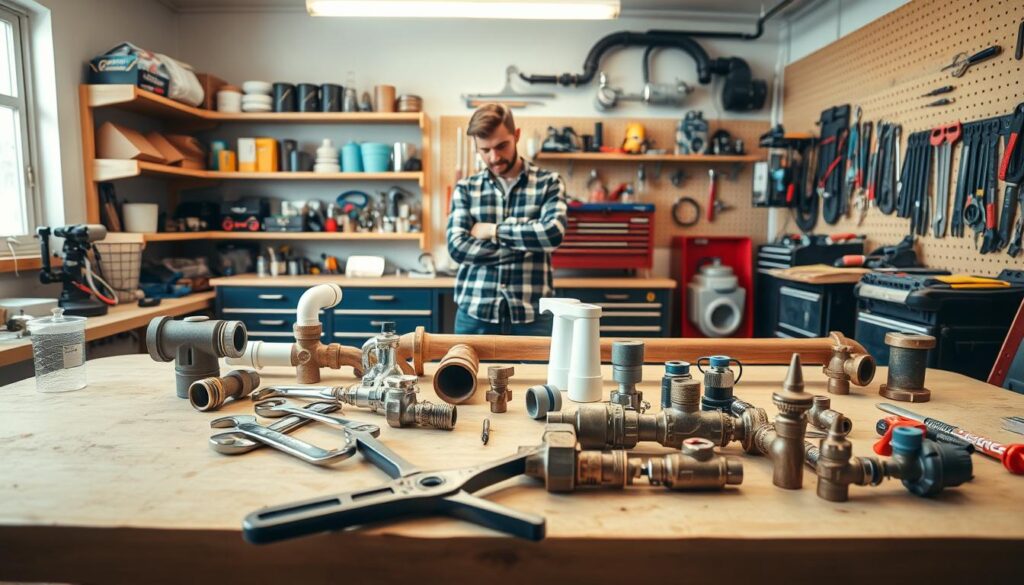
Fixing Leaky Faucets and Pipes
Fixing leaky faucets and pipes is a common DIY plumbing project that requires specific tools. You’ll need adjustable wrenches, basin wrenches, and Teflon tape to secure loose connections and replace worn-out washers or O-rings.
- Adjustable wrenches for gripping various pipe sizes
- Basin wrenches for reaching and tightening faucet mounting nuts
- Teflon tape for creating watertight seals on threaded connections
Installing New Fixtures
Installing new fixtures, such as faucets or toilets, requires a different set of tools. You’ll need pipe cutters, wrenches, and thread sealants to ensure proper installation and prevent leaks.
- Measure and mark the installation area accurately
- Cut pipes to the required length using pipe cutters
- Apply thread sealants to create a watertight seal
Replacing Pipe Sections
Replacing pipe sections is a more involved DIY plumbing project that requires careful planning and the right tools. You’ll need pipe cutters, pipe benders, and couplings to replace damaged or corroded pipe sections.
- Pipe cutters for cutting pipes to the required length
- Pipe benders for bending pipes to fit around obstacles
- Couplings for connecting new pipe sections to existing pipes
Unclogging Drains and Toilets
Unclogging drains and toilets is a common DIY plumbing task that requires the right tools. You’ll need plungers, drain snakes, and chemical drain cleaners to clear blockages and restore proper drainage.
- Use plungers to create suction and loosen blockages
- Feed drain snakes into the drain to break up or retrieve clogs
- Apply chemical drain cleaners to dissolve and clear blockages
By understanding the tools required for these common DIY plumbing projects, homeowners can tackle tasks with confidence and achieve professional-like results.
Conclusion: Investing in the Right Plumbing Equipment
Investing in the right plumbing equipment is crucial for the success of any DIY plumbing project. Having the right plumbing tools and quality plumbing supplies not only ensures that the job is done correctly but also enhances safety and efficiency.
By building a well-stocked toolkit with essential and specialized plumbing tools, DIY enthusiasts can tackle a variety of projects with confidence. Whether it’s fixing a leaky faucet, unclogging drains, or installing new fixtures, having quality plumbing supplies on hand makes all the difference.
When selecting plumbing equipment, consider the specific needs of your project, the quality of the tools, and your budget. Brands like Ridgid, Milwaukee, and SharkBite offer reliable and professional-grade plumbing supplies that can withstand the demands of DIY projects.
By investing in quality plumbing equipment, you can ensure that your DIY projects are completed efficiently and effectively, saving you time and money in the long run. So, take the first step in building your DIY plumbing toolkit and start exploring the world of plumbing projects with confidence.
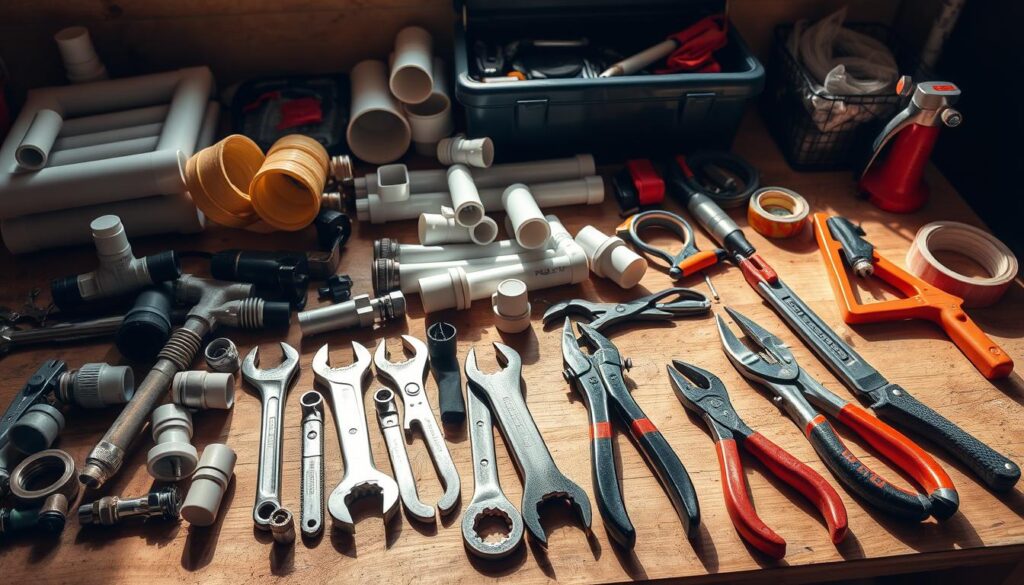
Pingback: Simple DIY Plumbing Repairs: Step-by-Step Guide - worldcivilsociety.com
Pingback: Essential DIY Plumbing Skills for Around the House - worldcivilsociety.com